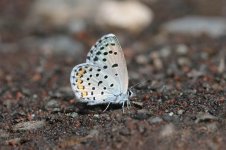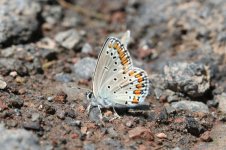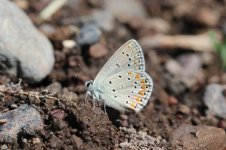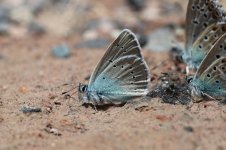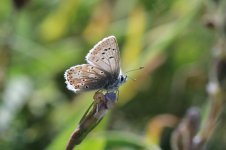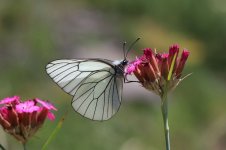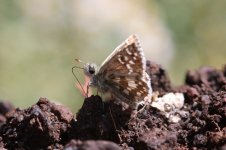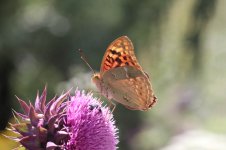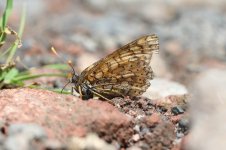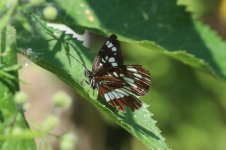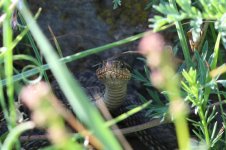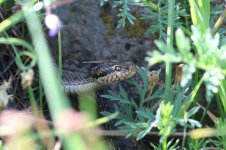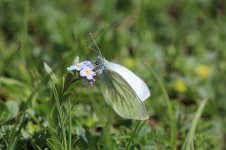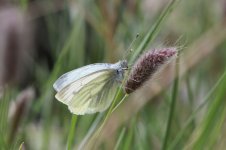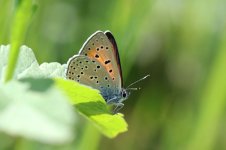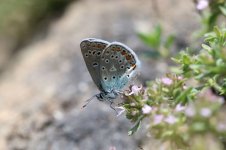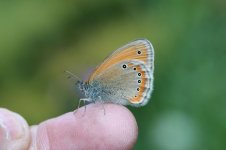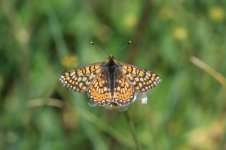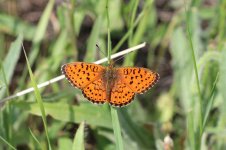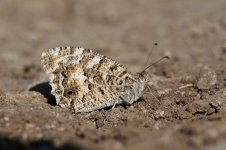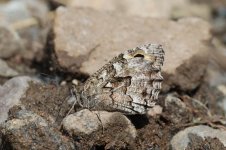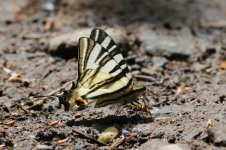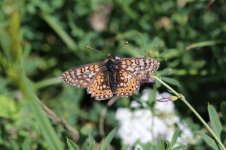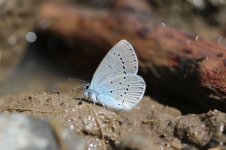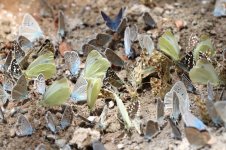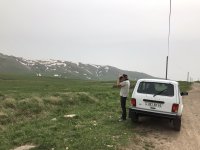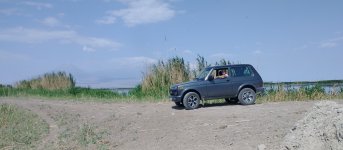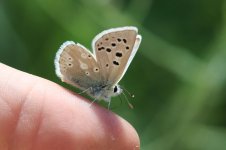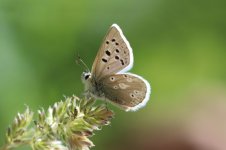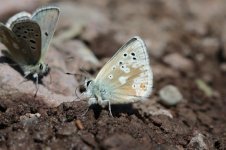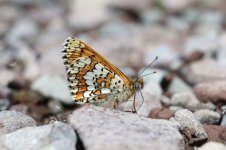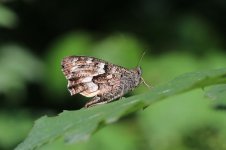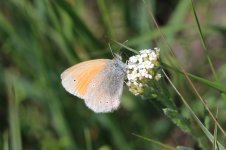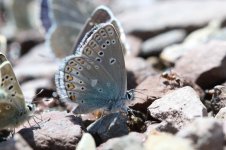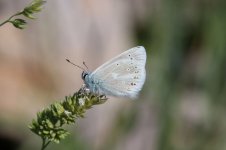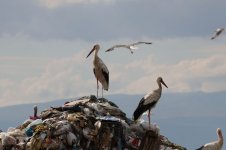
-
Welcome to BirdForum, the internet's largest birding community with thousands of members from all over the world. The forums are dedicated to wild birds, birding, binoculars and equipment and all that goes with it.
Please register for an account to take part in the discussions in the forum, post your pictures in the gallery and more.
You are using an out of date browser. It may not display this or other websites correctly.
You should upgrade or use an alternative browser.
You should upgrade or use an alternative browser.
Butterflies of Armenia, June-July 2022 (1 Viewer)
- Thread starter Jos Stratford
- Start date
More options
Who Replied?


29 June. Mount Aragats & Yerevan Botanical Garden.
Today's mission was high altitude, task to track down Bowden's White. Failed yet again on a quick check for Radde's Accentor in the juniper zone, thereafter arrived in the Alpine meadows beneath Lake Kiri at about 10.00 am, gloriously bathed in sunshine and already moderately warm. Though still a couple of weeks before Bowden's Whites should be flying in peak numbers, conditions seemed perfect and I was optimistic to find an early sunning individual. Painting Ladies and Small Coppers already on the wing and, in a matter of minutes, a white did fly past …unfortunately a high velocity individual again with seemingly no plans to settle this side of Turkey! Fortunately, after perhaps 20 minutes, another white appeared and this turned out to be a far more cooperative individual, repeatedly landing to nectar on forget-me-nots. Bowden's White confirmed and photographed.
Success. With that, returned to the lower slopes of the mountain and explored a very rich valley on the road to Amberd Castle. Lots of puddling blues near the road, Common Blues, Adonis Blues, Silver-studded Blues and Amanda's Blues in the main, but also a number of Turkmenistan Zephyr Blues, three Mazarine Blues, three Pontic Blues and several Chapman's Blues. Thereafter a long amble up the valley, exploring the lush streamside vegetation. Many butterflies here, the main highlights being an Anatolian Fiery Copper, four Russian Heaths, both Twinspot Fritillaries and Marsh Fritillaries and one Esper's Marbled White. Also seen here a couple of Old World Swallowtails, abundant Black-veined Whites, a dozen or so Woodland Ringlets, one Dark Rockbrown, several Purple-shot Coppers, five Dingy Skippers, three Olive Skippers and plentiful Orbed Red-underwing Skippers and Marbled Skippers. Assorted birds too, Ring Ouzels, Red-backed Shrikes, etc.
With plans to head south to Mount Gnishik, I departed the mountain mid-afternoon and headed to Yerevan for a brief visit to the city's botanical garden. Mostly fairly dense deciduous woodland, oak and the like, the botanical garden is far from a classic botanical garden, but still it did produce a few nice additions for the day - abundant Caucasian Squirrels and, on the butterfly front, plenty of Holly Blues, two Bluespot Hairstreaks and one White-letter Hairstreak.
Thereafter, negotiating Yerevan's not very impressive traffic, hit the road south and pulled into the village of Chiva a couple of hours later, base for tackling Mount Gnishik next morning.
Today's mission was high altitude, task to track down Bowden's White. Failed yet again on a quick check for Radde's Accentor in the juniper zone, thereafter arrived in the Alpine meadows beneath Lake Kiri at about 10.00 am, gloriously bathed in sunshine and already moderately warm. Though still a couple of weeks before Bowden's Whites should be flying in peak numbers, conditions seemed perfect and I was optimistic to find an early sunning individual. Painting Ladies and Small Coppers already on the wing and, in a matter of minutes, a white did fly past …unfortunately a high velocity individual again with seemingly no plans to settle this side of Turkey! Fortunately, after perhaps 20 minutes, another white appeared and this turned out to be a far more cooperative individual, repeatedly landing to nectar on forget-me-nots. Bowden's White confirmed and photographed.
Success. With that, returned to the lower slopes of the mountain and explored a very rich valley on the road to Amberd Castle. Lots of puddling blues near the road, Common Blues, Adonis Blues, Silver-studded Blues and Amanda's Blues in the main, but also a number of Turkmenistan Zephyr Blues, three Mazarine Blues, three Pontic Blues and several Chapman's Blues. Thereafter a long amble up the valley, exploring the lush streamside vegetation. Many butterflies here, the main highlights being an Anatolian Fiery Copper, four Russian Heaths, both Twinspot Fritillaries and Marsh Fritillaries and one Esper's Marbled White. Also seen here a couple of Old World Swallowtails, abundant Black-veined Whites, a dozen or so Woodland Ringlets, one Dark Rockbrown, several Purple-shot Coppers, five Dingy Skippers, three Olive Skippers and plentiful Orbed Red-underwing Skippers and Marbled Skippers. Assorted birds too, Ring Ouzels, Red-backed Shrikes, etc.
With plans to head south to Mount Gnishik, I departed the mountain mid-afternoon and headed to Yerevan for a brief visit to the city's botanical garden. Mostly fairly dense deciduous woodland, oak and the like, the botanical garden is far from a classic botanical garden, but still it did produce a few nice additions for the day - abundant Caucasian Squirrels and, on the butterfly front, plenty of Holly Blues, two Bluespot Hairstreaks and one White-letter Hairstreak.
Thereafter, negotiating Yerevan's not very impressive traffic, hit the road south and pulled into the village of Chiva a couple of hours later, base for tackling Mount Gnishik next morning.


John Muddeman
Well-known member
Lovely stuff Jos! I've only seen a relatively few late summer species there while guiding birding tours, but there's a wealth of species I'd love to go in spring to see. It looks like the temperatures weren't too bad either, which puts me off a little bit going at that time.

I intend to visit again next year, am thinking early spring and perhaps summer again, but also the south. Temperatures were fairly moderate, 20-30 C, largely because I was at altitude most of the time. Was hotter in the lowlands west of Yerevan, but I was only briefly in this area.I'd love to go in spring to see. It looks like the temperatures weren't too bad either, which puts me off a little bit going at that time.

A bit delayed in finishing this report, apologies
30 June. Mount Gnishik, Noravank & Vardenyats Pass.
Lada Niva came into its own, snaking its way up a rough rocky track to 2200 metres altitude. This is Caspian Snowcock territory, the high meadows above on all sides home to these elusive mountain birds. Eastern Imperial Eagle soared, Red-billed Chough tumbled through the skies, but I gave no time to birds of any kind, this was again a Grade A butterfly location - in contrast to the arid lower slopes, I was now in the midst of lush green and abundant flowers. And mega numbers of butterflies - on the verges either side of the track, hundreds of Black-veined Whites, several dozen Klug’s Tawny Browns, 70 or so Cardinal Fritillaires and at least 30 Freyer’s Fritillaries. No shortage of Hermits too, a minimum of 150 present. Leaving the car and hiking a little higher, very soon the species tally was soaring - among the abundant Hungarian Gliders and Marbled Whites, some of the classier butterflies included Lesser Lattice Browns, Large Tortoiseshell, four Eastern Graylings and several Tawny Rockbrowns.
Mass puddling of butterflies again, hundreds gathering wherever the stream crossed the track - not just 500+ Silver-studded Blues, along with abundant Common Blues and Amanda’s Blues, but also good numbers of Mazarine Blues and Adonis Blues, oodles of Sandy Grizzled Skippers, Oberthur’s Grizzled Skippers and Orbed Red Underwing Skippers. Also added 15 Scarce Swallowtails at one spot, three Ripart’s Anomalous Blues, four Olive Skippers, two Dingy Skippers, one Inky Skipper and a Saadi’s Heath. A local gent tending bees wandered down to say hello, probably was a little bemused to find me on my belly on damp soil aside a stream. Pulling myself away from the puddling spectacles, quite an allure on the flowers too, not least Nettle-tree Butterflies, Southern White Admirals and a Lesser Fiery Copper. With occasional scans of the slopes around for birds et al, one very notable non-butterfly also put in an appearance, albeit very distant - one Brown Bear on a meadow edge on a hillside adjacent. Only the fourth mammal species of the trip, excluding roadkill Hedgehog and Red Fox.
Slowly wandering back to the car, added Blue Spot Hairstreak, Gerhard’s Black Hairstreak and Osiris Blue. By 11 am, butterfly activity was at its peak - I had amassed over 50 species at this point, but the overriding memory is of the absolute sheer numbers of individuals. Nearly all were in pristine fresh condition, I have to assume a major emergence in days prior. Deciding to descend, I made quite a number of additional stops on route down. Overall however, as I left the higher slopes, butterfly numbers declined, only Hermits and Marbled Whites staying in any abundance in the far drier slopes near Chiva village.
With plenty of time at my disposal, next stop was a return to the excellent gorge below Novarank Monastery. Not sure what I expected here beyond the abundance seen a week earlier, but I was not to be disappointed - still most of the species seen previously in very good numbers, including Yellow-banded Skipper et al, but also only my second Meleager’s Blue of the trip and two totally new species for me, several Fidussi’s Blues and an Armenia Orange-banded Hairstreak.
With an absolute feast of butterflies at both Gnishik and Novarank, the question was where to go now?! I had initially debated spending the last few days in the far south near the Iranian border, but having missed quite a few species at Arakelots and Janjur in the north due to rain, that also appealed very much. With the rationale that Armenia was truly impressing me, I decided there and then that a second visit to the country would follow in the not too distant future. On that I could explore the south, so with that I turned and headed north.
Retracing my route taken earlier, a half hour later I was again climbing through the Vardenyats Pass, a stop on the steep hairpins a little below the highest point again very productive - among the selection, two Clouded Apollos, a couple of Pearly Heaths, four Twinspot Fritillaries, two Knapweed Fritillaries and two Marsh Fritillaries. Over the top of the pass, onto the open relatively flat plateau, exactly where I had hit cloud the week before. This day however was still bright and sunny, the vast grassland steppe awash with flowers and seemingly absolutely perfect for butterflies. Parked and walked, Common Rosefinches and Black-headed Yellow Wagtails common, a Rock Sparrow, a few flocks of Rose-coloured Starlings, but a strange absence of butterflies in any real numbers. Perhaps the time of day, now almost 16.00, but the only butterflies relatively common were Small Heaths, Eastern Bath Whites and Queen of Spain Fritillaries. Still, did find one new butterfly for the trip - in its vivid colours, almost flashing bright orange and green as it flew, one male Greek Clouded Yellow. A couple of female types nearby were maybe also of this species.
With that, I continued north, passed Lake Semen and its Armenian Gulls and eventually reached Dilijan, just about the only town in Armenia that I would describe as picturesque. Nice place to stay overnight. After evening tallies and sorting out a few identifications, the species count for this day stood at almost 70, an impressive total.
30 June. Mount Gnishik, Noravank & Vardenyats Pass.
Lada Niva came into its own, snaking its way up a rough rocky track to 2200 metres altitude. This is Caspian Snowcock territory, the high meadows above on all sides home to these elusive mountain birds. Eastern Imperial Eagle soared, Red-billed Chough tumbled through the skies, but I gave no time to birds of any kind, this was again a Grade A butterfly location - in contrast to the arid lower slopes, I was now in the midst of lush green and abundant flowers. And mega numbers of butterflies - on the verges either side of the track, hundreds of Black-veined Whites, several dozen Klug’s Tawny Browns, 70 or so Cardinal Fritillaires and at least 30 Freyer’s Fritillaries. No shortage of Hermits too, a minimum of 150 present. Leaving the car and hiking a little higher, very soon the species tally was soaring - among the abundant Hungarian Gliders and Marbled Whites, some of the classier butterflies included Lesser Lattice Browns, Large Tortoiseshell, four Eastern Graylings and several Tawny Rockbrowns.
Mass puddling of butterflies again, hundreds gathering wherever the stream crossed the track - not just 500+ Silver-studded Blues, along with abundant Common Blues and Amanda’s Blues, but also good numbers of Mazarine Blues and Adonis Blues, oodles of Sandy Grizzled Skippers, Oberthur’s Grizzled Skippers and Orbed Red Underwing Skippers. Also added 15 Scarce Swallowtails at one spot, three Ripart’s Anomalous Blues, four Olive Skippers, two Dingy Skippers, one Inky Skipper and a Saadi’s Heath. A local gent tending bees wandered down to say hello, probably was a little bemused to find me on my belly on damp soil aside a stream. Pulling myself away from the puddling spectacles, quite an allure on the flowers too, not least Nettle-tree Butterflies, Southern White Admirals and a Lesser Fiery Copper. With occasional scans of the slopes around for birds et al, one very notable non-butterfly also put in an appearance, albeit very distant - one Brown Bear on a meadow edge on a hillside adjacent. Only the fourth mammal species of the trip, excluding roadkill Hedgehog and Red Fox.
Slowly wandering back to the car, added Blue Spot Hairstreak, Gerhard’s Black Hairstreak and Osiris Blue. By 11 am, butterfly activity was at its peak - I had amassed over 50 species at this point, but the overriding memory is of the absolute sheer numbers of individuals. Nearly all were in pristine fresh condition, I have to assume a major emergence in days prior. Deciding to descend, I made quite a number of additional stops on route down. Overall however, as I left the higher slopes, butterfly numbers declined, only Hermits and Marbled Whites staying in any abundance in the far drier slopes near Chiva village.
With plenty of time at my disposal, next stop was a return to the excellent gorge below Novarank Monastery. Not sure what I expected here beyond the abundance seen a week earlier, but I was not to be disappointed - still most of the species seen previously in very good numbers, including Yellow-banded Skipper et al, but also only my second Meleager’s Blue of the trip and two totally new species for me, several Fidussi’s Blues and an Armenia Orange-banded Hairstreak.
With an absolute feast of butterflies at both Gnishik and Novarank, the question was where to go now?! I had initially debated spending the last few days in the far south near the Iranian border, but having missed quite a few species at Arakelots and Janjur in the north due to rain, that also appealed very much. With the rationale that Armenia was truly impressing me, I decided there and then that a second visit to the country would follow in the not too distant future. On that I could explore the south, so with that I turned and headed north.
Retracing my route taken earlier, a half hour later I was again climbing through the Vardenyats Pass, a stop on the steep hairpins a little below the highest point again very productive - among the selection, two Clouded Apollos, a couple of Pearly Heaths, four Twinspot Fritillaries, two Knapweed Fritillaries and two Marsh Fritillaries. Over the top of the pass, onto the open relatively flat plateau, exactly where I had hit cloud the week before. This day however was still bright and sunny, the vast grassland steppe awash with flowers and seemingly absolutely perfect for butterflies. Parked and walked, Common Rosefinches and Black-headed Yellow Wagtails common, a Rock Sparrow, a few flocks of Rose-coloured Starlings, but a strange absence of butterflies in any real numbers. Perhaps the time of day, now almost 16.00, but the only butterflies relatively common were Small Heaths, Eastern Bath Whites and Queen of Spain Fritillaries. Still, did find one new butterfly for the trip - in its vivid colours, almost flashing bright orange and green as it flew, one male Greek Clouded Yellow. A couple of female types nearby were maybe also of this species.
With that, I continued north, passed Lake Semen and its Armenian Gulls and eventually reached Dilijan, just about the only town in Armenia that I would describe as picturesque. Nice place to stay overnight. After evening tallies and sorting out a few identifications, the species count for this day stood at almost 70, an impressive total.


Richard Prior
Halfway up an Alp

Richard Prior
Halfway up an Alp

Ooh, the fancy-wheeled one, there’s posh as my Welsh Mother in law would say!

1 July. Arakelots Beech Forest & Janjur Pass.
Peered out of the window at 7.00 am, half expected cloud and rain. But no, blue sky and a samamisicus Common Redstart singing its heart out. Wasted no time, departed and drove the hour or so to Arakelots, amazingly still sunny on arrival. On the entrance track, many Great Banded Graylings, new for the trip, plus quite a few Commas and Speckled Woods, the latter also new for the trip. Navigated the rutted and still muddy track, turning the car a nice mud-splattered brown. Parked beneath the path up to Arakelots Monastery and set off to explore the patchwork of small meadows.
A vaguely European feel with the lush deciduous forest all around, and the butterfly mix somewhat similar too - abundant thistles bustling with Peacocks, Red Admirals, Painted Ladies and Cardinals, then small meadows full of Meadow Browns and Common Blues. Among the highlights, three Eastern Graylings, three Weaver's Fritillaries, both Sooty Copper and Lesser Fiery Copper and one Ilex Hairstreak. Back on the muddy track, Hungarian Gliders in no short supply, Nettle-tree Butterflies and a number of Holly Blues beginning to puddle and one Southern White Admiral. These were joined by my only Wood White of the trip, plus a Large Tortoiseshell, a couple of Olive Skippers and a Mallow Skipper, the latter only my third of the trip.
Had thought about staying longer and walking some kilometres along the riverside track, but with sun in full control, the lure of the Janjur Pass some 150 km to the west proved too strong, my previous visit to this amazing site also truncated by weather.
A couple of hours later, parking at Janjur, conditions were perfect, skies blue, pleasantly warm, a light breeze. Having already explored the southern side of the pass, I this time climbed the slopes to the north, Lederer's Heaths and Glanville Fritillaries immediately seen, soon followed by Alcon Blue. The jewel in the crown however was an exquisite Gavarnie Blue, a highland specialist sporting pale pastel blue, almost ghostly in appearance. With this in the bag, I decided to check out a valley a kilometre or so further …and if I had not been impressed enough with the Gavarnie Blue a little earlier, I certainly was here - a mass puddling of 180+ Gavarnie Blues! Quite a spectacle, numerous Adonis Blues and Silver-studded Blues too, plus Balkan Zephyr Blues and a scattering of Brown Argus, Mazarine Blues, Small Blues and Osiris Blues. Also one Turquoise Blue.
As it turned out, the whole of this valley was very productive - not only a rich mix of other blues (Common Blues, Amanda's Blues, etc) and Purple-shot Coppers, but also several Clouded Apollos, four Russian Heaths and plentiful Woodland Ringlets. A pleasant couple of hours here, also wandering south of the road to add a few more butterflies, Mazarine Blues et al, then I departed for the drive back towards Yerevan. Destination this night was Byurakan, closest village to Mount Aragats.
Peered out of the window at 7.00 am, half expected cloud and rain. But no, blue sky and a samamisicus Common Redstart singing its heart out. Wasted no time, departed and drove the hour or so to Arakelots, amazingly still sunny on arrival. On the entrance track, many Great Banded Graylings, new for the trip, plus quite a few Commas and Speckled Woods, the latter also new for the trip. Navigated the rutted and still muddy track, turning the car a nice mud-splattered brown. Parked beneath the path up to Arakelots Monastery and set off to explore the patchwork of small meadows.
A vaguely European feel with the lush deciduous forest all around, and the butterfly mix somewhat similar too - abundant thistles bustling with Peacocks, Red Admirals, Painted Ladies and Cardinals, then small meadows full of Meadow Browns and Common Blues. Among the highlights, three Eastern Graylings, three Weaver's Fritillaries, both Sooty Copper and Lesser Fiery Copper and one Ilex Hairstreak. Back on the muddy track, Hungarian Gliders in no short supply, Nettle-tree Butterflies and a number of Holly Blues beginning to puddle and one Southern White Admiral. These were joined by my only Wood White of the trip, plus a Large Tortoiseshell, a couple of Olive Skippers and a Mallow Skipper, the latter only my third of the trip.
Had thought about staying longer and walking some kilometres along the riverside track, but with sun in full control, the lure of the Janjur Pass some 150 km to the west proved too strong, my previous visit to this amazing site also truncated by weather.
A couple of hours later, parking at Janjur, conditions were perfect, skies blue, pleasantly warm, a light breeze. Having already explored the southern side of the pass, I this time climbed the slopes to the north, Lederer's Heaths and Glanville Fritillaries immediately seen, soon followed by Alcon Blue. The jewel in the crown however was an exquisite Gavarnie Blue, a highland specialist sporting pale pastel blue, almost ghostly in appearance. With this in the bag, I decided to check out a valley a kilometre or so further …and if I had not been impressed enough with the Gavarnie Blue a little earlier, I certainly was here - a mass puddling of 180+ Gavarnie Blues! Quite a spectacle, numerous Adonis Blues and Silver-studded Blues too, plus Balkan Zephyr Blues and a scattering of Brown Argus, Mazarine Blues, Small Blues and Osiris Blues. Also one Turquoise Blue.
As it turned out, the whole of this valley was very productive - not only a rich mix of other blues (Common Blues, Amanda's Blues, etc) and Purple-shot Coppers, but also several Clouded Apollos, four Russian Heaths and plentiful Woodland Ringlets. A pleasant couple of hours here, also wandering south of the road to add a few more butterflies, Mazarine Blues et al, then I departed for the drive back towards Yerevan. Destination this night was Byurakan, closest village to Mount Aragats.



2 July. Mount Aragats & Ranchpar Fish Pools.
Final day in Armenia. Classic birding on Mount Aragats - kicked off with a pair of Western Rock Nuthatches on a rocky gorge above Byurakan, then resumed the hunt for Radde's Accentor in the juniper zone a few kilometres up. No shortage of quality birds on show - Ring Ouzels, Barred Warblers, Rock Thrush, White-throated Robin, Red-backed Shrikes, Rock Buntings, Ortolan Buntings, Black-headed Buntings - but yet again no sign of Radde's Accentor. With patchy cloud persuading me not to return to butterflies, I decided to continue searching, now using the small road towards Amberd Castle. A kilometre or so along, the tumble-down remnants of a sheep corral caught my eye, 'worth a quick explore' thought I. And indeed it was, a real little hotspot - Rock Sparrows breeding in one corner, Ring Ouzels feeding fledglings at the rear, several Crag Martins using the rear shelters and, piece de la resistance, finally one stunning Radde's Accentor. Alternating between patches of bare ground, the inside of the rear shelters and the rocky walls, this was immediately elevated to 'bird of the trip'.
A bit of butterfly distraction (Blue Argus, Geranium Argus, Turkish Copper, Lesser Fiery Copper, etc), then a resumption of birding with a shift to the higher slopes around Kari Lake. Lucky I wasn't seeking out butterflies - rolling fog and a mere 12 C there. Alpine Chough, Shore Larks, Black Redstarts, Twite, Northern Wheatears …about the sum of it before I decided the sunshine of the lowlands now beckoned.
With still some hours before I needed to head to the airport, a random perusal of Google maps showed what appeared to be a reasonably-sized area of fish pools near Ranchpar on the Turkish border. Certainly was not a match for Armash, but they were pretty impressive nonetheless - in temperatures of 35 C, hundreds of Pygmy Cormorants, many Whiskered Terns, a couple of dozen Ferruginous Ducks, a good mix of herons (numerous Grey Herons, several Purple Herons, dozens of Squacco Herons, two Little Bitterns, a hundred and or so Little Egrets, a few flocks of Cattle Egrets) and added extras such as Black-necked Grebes, Penduline Tit and Hobby. In the general area, plenty of Rollers and European Bee-eaters, plus an amazing density of White Storks, mass colonies of them in each village.
And so approached the end of the trip, an accidental detour east of Yerevan provided the highly 'scenic' final destination of the trip …Yerevan rubbish tip! Absolutely heaving with birds, approximately 200 White Storks picking through the piles of rubbish, thousands of Armenian Gulls, one Black Kite (only my third of the trip). Didn't have the option to stay long however at this pungent site - workers were not impressed with me taking photographs of the tip. I was told to leave. Nearby wasteland added the final new species for the trip - alongside Common Blue and Eastern Bath White, one Persian Fritillary.
Trip over, headed for the airport, night flight out.
Final day in Armenia. Classic birding on Mount Aragats - kicked off with a pair of Western Rock Nuthatches on a rocky gorge above Byurakan, then resumed the hunt for Radde's Accentor in the juniper zone a few kilometres up. No shortage of quality birds on show - Ring Ouzels, Barred Warblers, Rock Thrush, White-throated Robin, Red-backed Shrikes, Rock Buntings, Ortolan Buntings, Black-headed Buntings - but yet again no sign of Radde's Accentor. With patchy cloud persuading me not to return to butterflies, I decided to continue searching, now using the small road towards Amberd Castle. A kilometre or so along, the tumble-down remnants of a sheep corral caught my eye, 'worth a quick explore' thought I. And indeed it was, a real little hotspot - Rock Sparrows breeding in one corner, Ring Ouzels feeding fledglings at the rear, several Crag Martins using the rear shelters and, piece de la resistance, finally one stunning Radde's Accentor. Alternating between patches of bare ground, the inside of the rear shelters and the rocky walls, this was immediately elevated to 'bird of the trip'.
A bit of butterfly distraction (Blue Argus, Geranium Argus, Turkish Copper, Lesser Fiery Copper, etc), then a resumption of birding with a shift to the higher slopes around Kari Lake. Lucky I wasn't seeking out butterflies - rolling fog and a mere 12 C there. Alpine Chough, Shore Larks, Black Redstarts, Twite, Northern Wheatears …about the sum of it before I decided the sunshine of the lowlands now beckoned.
With still some hours before I needed to head to the airport, a random perusal of Google maps showed what appeared to be a reasonably-sized area of fish pools near Ranchpar on the Turkish border. Certainly was not a match for Armash, but they were pretty impressive nonetheless - in temperatures of 35 C, hundreds of Pygmy Cormorants, many Whiskered Terns, a couple of dozen Ferruginous Ducks, a good mix of herons (numerous Grey Herons, several Purple Herons, dozens of Squacco Herons, two Little Bitterns, a hundred and or so Little Egrets, a few flocks of Cattle Egrets) and added extras such as Black-necked Grebes, Penduline Tit and Hobby. In the general area, plenty of Rollers and European Bee-eaters, plus an amazing density of White Storks, mass colonies of them in each village.
And so approached the end of the trip, an accidental detour east of Yerevan provided the highly 'scenic' final destination of the trip …Yerevan rubbish tip! Absolutely heaving with birds, approximately 200 White Storks picking through the piles of rubbish, thousands of Armenian Gulls, one Black Kite (only my third of the trip). Didn't have the option to stay long however at this pungent site - workers were not impressed with me taking photographs of the tip. I was told to leave. Nearby wasteland added the final new species for the trip - alongside Common Blue and Eastern Bath White, one Persian Fritillary.
Trip over, headed for the airport, night flight out.

Andy Adcock
Worst person on Birdforum

South Africans call them 'Red Romans' and they do have a painful bite apparently.I stepped on a Camel Spider with bare feet while camping near Sossusvlei, Namibia, luckily it turned out to be an empty husk - I don't think I'd want to get bitten by those fangs!
Users who are viewing this thread
Total: 2 (members: 0, guests: 2)




